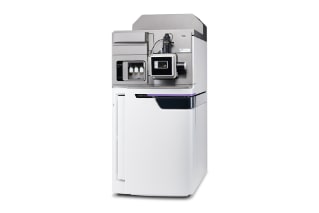SYNAPT XS
Ultimate flexibility for deeper discovery
In the arena of scientific discovery, the slow pace of advancement and escalating costs of research can prove to be a challenge. Unlike competitor systems with restricted inlet options, scan function limitations, or requiring multiple platforms, only Waters offers an all-encompassing high-performing LC-MS solution, the SYNAPT XS mass spectrometer, for ultimate flexibility and greater freedom of analytical choice – supporting scientific creativity and technical success for any application.
- Novel technology building blocks deliver cutting-edge analytical performance
- SONAR and HDMSE provide a unique toolkit for interrogating complex mixtures
- Ion mobility multiplies peak capacity and selectivity of analysis
- CCS measurements increase security of compound identification
- Deeper discovery in Mass Spectrometry Imaging with Full Spectrum Molecular Imaging enabled by DESI XS and MALDI
Overview
- Serve the broadest range of applications with the most extensive range of chromatograph inlets for ultimate flexibility
- Attain fragment ion information for every detectable component for unambiguous confirmation of compound identity with DIA modes SONAR, MSE, and HDMSE
- Generate rich fragmentation data from highly complex samples in all acquisition modes including DDA
- Simplify and streamline the mass spectral imaging workflow and deliver multi-layered, information-rich data with multiple imaging techniques and accompanying High Definition Imaging (HDI) Software
- Achieve automated higher order structure determination thorough confident identification, intact mass analysis, and best-in-class reproducibility
- Enhance MS/MS possibilities using complementary fragmentation techniques with high resolution and accurate mass measurements
Recommended Use: For deeper discovery by aligning complimentary workflows on a single Ion mobility enabled time-of-flight mass spectrometer with the flexibility of multiple ion sources and acquisition modes.
Features Header
Cutting edge performance with novel technology
With technology building blocks inherited from the Waters Advanced Mass Spectrometry SELECT SERIES, advanced innovation is built-in, ensuring scientists using this platform are at the cutting edge of mass spectrometry while retaining the ease of use and established end-to-end workflows for which the SYNAPT is well known.
- StepWave XS - Redesigned segmented quadrupole transfer optics provide enhanced sensitivity for challenging compounds while further improving levels of analytical robustness.
- Extended ToF - Delivers UPLC-compatible mass resolution, matrix-tolerant dynamic range, and quantitative results for the most complex samples, while offering superior specifications to previous SYNAPT models.
Interrogate complex mixtures with a unique toolkit
A complete analytical strategy requires the combination of appropriate complementary techniques to see the bigger picture. With both SONAR and IMS-based data independent acquisition (DIA) modes of operation on the SYNAPT XS, the discovery analyst is in a unique position to interrogate complex mixtures by complementary mechanisms. Both types of acquisition increase analytical peak capacity, providing ‘clean and clear’ fragmentation data, but based on different molecular properties. This provides a truly unique investigative toolbox for the in-depth interrogation of complex mixtures.
Discover more with ion mobility and CSS measurement
Conventional mass spectrometers separate components based on m/z. The SYNAPT XS also allows separation of molecules according to their size, shape, and charge during ion mobility experiments as a function of their collisional cross section (CCS). As well as ion mobility offering an additional dimension of resolution, multiplying peak capacity, and selectivity of analysis the measurement of CCS offers additional molecular identifiers. The measured CCS of an ion can be used to help confirm an ion’s identity or investigate its structure. The inclusion of ion mobility significantly increases the extent and confidence with which a scientist can profile complex mixtures and complex molecules – dramatically enhancing sample definition.
Achieve ultra-confident structural characterization of components
Time aligned parallel (TAP) fragmentation is an acquisition mode unique to the T-Wave IMS design. It permits users to take the advantage of the TriWave configuration, which allows the pre-IMS T-Wave and post-IMS T-Wave to operate as two separate collision cells. The resultant CID-IMS-CID instrumental operation helps to provide ultra-confident structural characterization of components. TAP fragmentation provides a distinct advantage for building a complete structure, through superior fragment ion coverage, sensitivity, and accuracy compared to traditional MSn or MS/MS techniques.
